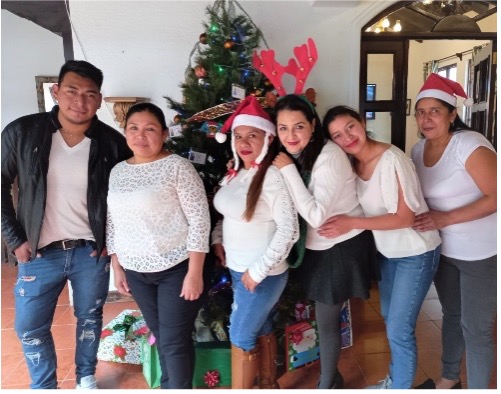Guatemala City, Guatemala – 30 minutes after arriving at Central America’s largest city, the four women that accompanied me to this hauntingly beautiful and captivating country were already questioning my judgement. Following me like a gaggle of geese past immigration, getting our passports stamped and headed to the car rental agency, it was dark outside and stairways were dimly lit.
“Did you get the extra insurance?” said one. “Ron, do you know where you’re going?” said another. “Yes, I do. And I got the extra insurance.” To alleviate any further concerns, I also said “And an SUV.”
My newly formed tour group consisted of two retirees and two mid-level career individuals. We were traveling through the Guatemalan Highlands, dodging agricultural workers through a wrong turn into a dirt road surrounded by broccoli and onion starts. Only minutes before, we were in a canyon with oxen, attempting to cross a washed-out portion of the highway with a river where the road should be, with one shouting, “Oh hell no.”
Driving around Guatemala really takes the standard driver’s license to the next level. Road rules, sometimes obvious to Americans who may take them for granted in the United States, can sometimes appear ‘optional,’ and with good reason. Distances are an illusion.
“It’s only 14 miles from the UNESCO World Heritage Site of Antigua to the capital?” Asked one of the travelers. “Yes” I said, with a slight pause.
In the absence of large-scale, American-style freeways, 14 miles to travel can and did take over two hours. Don’t bother relying on Google Maps or MapQuest to select the most efficient trip when a pre-Easter parade blocks the main Central American, CA-1 highway. There aren’t options beyond going in circles because traffic police are redirecting cars in a direction opposite from what is being fed into a smartphone map app.
Tourism is indeed on the rebound in Guatemala, despite a United States Department State Advisory suggesting otherwise. Numbers indicate that it is on the rebound, complete with new port facilities to transfer cruise ship passengers from Port Quetzal into the highlands.
There are two ways to visit Guatemala, the country next after Mexico. One is by booking an escorted trip, which can be pricey, but everything is covered to the degree possible to provide an insulated experience. This method, should you choose it can be fantastic. First rate accommodations, five-star hotels and everyone speaks English at every corner. This being my first tour group, I opted to keep it small, and the theme was experiences. Everything was built on sensory experiences, steering away from a soft, protected cocoon.
GUATEMALA CITY
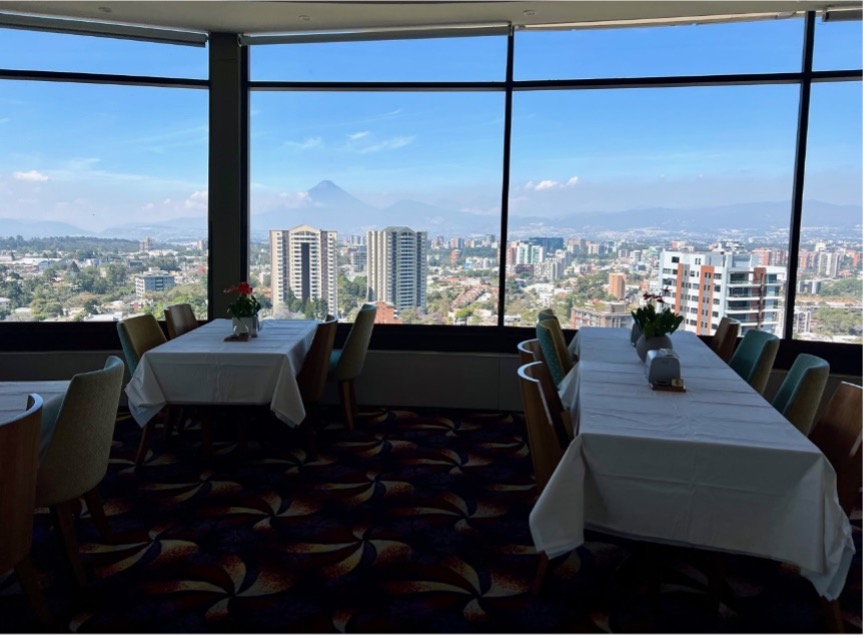
Arriving at the capital’s newest hotel destination, Vista Quince Hotel, is situated in the southeast residential zone; this hotel is nothing short of spectacular. Originally slated for opening prior to COVID, it was pushed out as the pandemic took its toll worldwide. As restrictions eased, Vista Quince Hotel has only recently resumed normal operation. Staffing issues throughout the Americas are endemic, and such is the case at Vista Quince Hotel. What makes this hotel exceptional is the service provided, even with reduced staffing.
Upon hotel check-in, our group was rather hungry; two flight legs beginning from Seattle yielded only those in-flight biscotti cookies and a tight connection time at Los Angeles International. None of us had time while on layover to grab airport food to go and we arrived at our connecting gate as boarding was completing.
At the Vista Quince, the front desk receptionist was a wealth of information, and we inquired about close access to restaurants. The receptionist suggested we might be interested in the hotel restaurant. A quick phone call ensued to determine if the restaurant staff was willing to host a small, very late group. Fortunately for us, and with much gratitude, they obliged. Soon, our group of five was whisked to the top of the hotel to Central America’s newest and only revolving restaurant. We hurriedly placed our order, profusely thanked the staff for seating us, and all enjoyed what is arguably a top-notch restaurant with incredible views over a hurried forty-five-minute meal. Everywhere we went, it was scenarios like this that reinforced the authentic hospitality that Guatemalans extended to us.
PANAJANCHEL
The next morning, we squeezed into our 7-seater SUV and took a beautiful country drive to the idyllic lakeside village of Panajanchel. Situated in an alluvial plain roughly three hours outside the capital, Panajanchel is comprised of roughly eleven thousand people. “Pana,” according to the locals, owes its existence primarily as an access ferry terminal for the surrounding villages on Lake Atitlan. Pana was formed via an explosive eruption 12,000 years ago, and the land gradually became a micro-caldera and eventually filled with rain run-off to become the deepest lake in Central America.
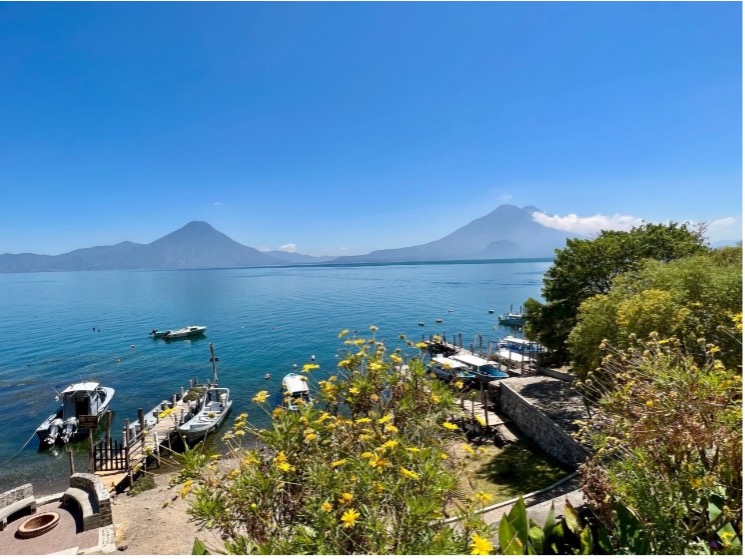
Visitors can find solitude and warm vibes from the villages that surround Lake Atitlan
Arguably one of the world’s top ten most scenic lakes, Panajanchel is the marketplace for everything Mayan. Opting for the established Porta Hotel Del Lago, we were blessed with close proximity to the sights of street vendors, and sounds from nearby church bells, hawkers shouting in Spanish and hustle bustle of humanity.
What was once a sleepy village, still manages to keep its artistic soul intact, with Mayan women wearing their traditional dress, not for tourists but out of necessity. After the end of the 36-year civil war in Guatemala, tourism slowly began returning. Foreign visitors noticed the incredible design patters of what the indigenous populations would wear daily. The women eventually started a cooperative supporting one another.
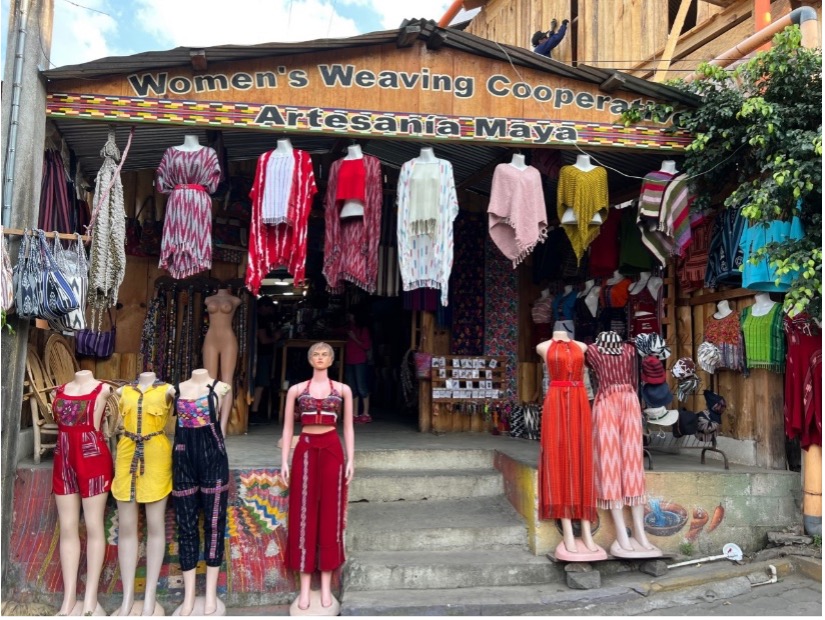
Panajanchel’s economy was once dominated by raw resources. Today, it is rapidly emerging as an Ex-pat community heavily reliant on retiree’s.
In Pana, you’re also three hours away from the nearest big box stores in Guatemala City, and clothing here comes from locally sourced resources such as cotton. A half hour boat ride across Lake Atitlan lies the women of San Juan la Laguna. They greeted us at the boat dock wearing the fabrics that define who they are. These women perfected their craft over centuries. Traditionally, the men would work in the fields and clothing was tailored with an eye towards durability. Using plant-based fibers and dyes, it didn’t take long for sustainable clothing to be created. What makes these designs unique is that each style is idiosyncratic to the village they come from. Much like an American-style letterman jacket, one can identify what village they’re from solely from the designs stitched.
Here, one can experience several different cooperatives dedicated to sustainable tourist and business practices. The Mayan Woman Cooperative offer great learning experiences as they demonstrate the process from beginning to end of the clothing that represents their villages.
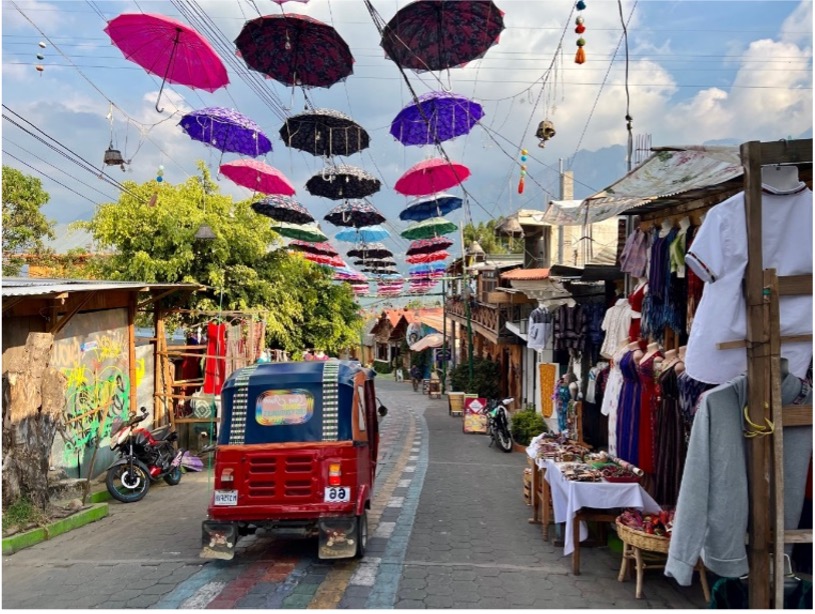
A lively street scene from San Juan la Laguna, on the shores of Lake Atitlan, Panajanchel, Guatemala.
My friend and local guide Roberto was well-versed in the history, culture, and area restaurants. He successfully secured a private boat excursion to the village of San Juan la Laguna. San Juan is primarily Tz’utijil Mayan (one of 26 different indigenous populations) and is known for artisan crafts, authentic chocolates, and coffee. It is also not uncommon to see youngsters helping to bag whole coffee beans in preparation for being shipped. Schooling in these parts are challenging and not everyone is afforded that opportunity to learn.
Red tuk-tuks rule the roads, and for a small price, they can escort you up the very hilly terrain to quaint coffee shops, picturesque art galleries, and numerous restaurants and cafes. Prices are reasonable and here, you’re not inclined to be overcharged. Roberto not only interpreted for those that didn’t speak English, but he maneuvered separate lunch checks in my group.
I had challenges using geo-location apps internationally to get around Guatemala and struggled to rely on popular, standard map sourcing found on my smartphone. For some reason, these programs couldn’t function despite a very strong cellular signal. Fortunately, another traveler had success using different programs. We wandered slowly through the canyons that hugged Lake Atitlan, stopping off at Mirador Mario Montenegro for unforgettable views and watching paragliders launch. Driving towards Antigua, we wandered through the very busy village of Patzun with Friday shoppers crowding the streets. Despite the distance between Panajanchel and Antigua being less than 50 miles (79 kilometers), the drive up from Lake Atitlan to the plateaus took well over two hours on excellent, well-kept roads that are fraught with twists and hairpin turns similar to climbing over steep mountain passes.
ANTIGUA
The UNESCO World Heritage Site of Antigua has been featured in countless magazines, periodicals, and even today, it still does not disappoint. Antigua was originally the capital of the entire Central American Republic from 1823–1841 (something akin in its day to the European Union). During the last 200 years, many Central American countries separated to reflect the political boundaries we know today.
Decimated at least three times over by massive earthquakes and volcanic eruptions, Antigua continues to keep an eye on the seismic activity, after all, Guatemala is part of the very active Pacific Ring of Fire. Despite that, tourists flock to Antigua to embrace a quieter way of life. There are several hotels to choose from; what makes Antigua attractive from a monetary perspective is a price point for every traveler, ranging from youth hostels to the newly opened colonial-styled chateau of Villa Bokeh and other exemplary five-star-plus accommodations.
Although my personal choice of San Rafael Hotel near the famed Santa Catalina Arch wasn’t available, we opted instead for the Hotel Meson De Valle, which offered very attractive pricing for what was an otherwise city-entirely-sold-out weekend when we visited in March, 2023. Though many hotels offer breakfast, we opted to take advantage of the San Martin restaurant just steps outside the hotel. This chain of restaurants is well-known to many Guatemalans and does not disappoint.
Dinner was an easy walk a few blocks from our hotel (careful of the cobblestone streets and high curbs) at the renowned Como Como restaurant. Our entourage attempted a walk-in with no reservations, especially on a busy weekend. True to form, the Guatemalan spirit of accommodation was in high gear. We were placed in a very cozy corner of the bar with a delightful bartender who apologized profusely for the delay in food. Here, one enjoys the finer aspects of life, slowing down and savoring everything Como Como had to offer. Everything prepared is organic, cooked over an open flame and nary a microwave within ten miles. For that, apologies are never needed.
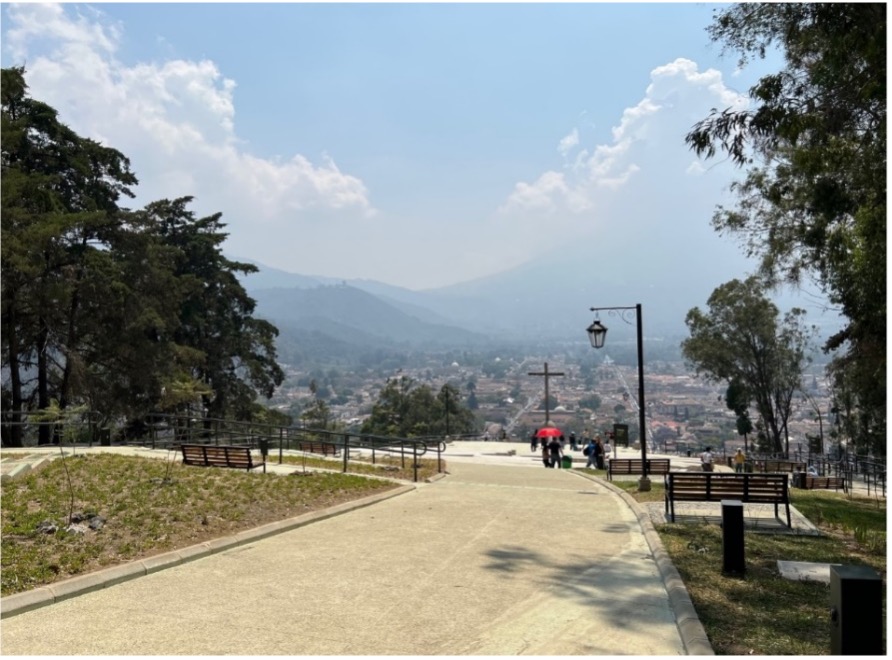
Terra De La Cruz or Cross on the Hill offers shade and sun to soak up the iconic views offered in the UNESCO World Heritage Site of Antigua, Guatemala.
New to the scene is an expansive and much appreciated view point overlooking Antigua is the renovated, Cross on the Hill park. Instead of the dry, well-worn plateau marked with a sketchy forest trail (replete with the potential for petty thieves), today’s renovation is complete with enhanced security, modern restrooms, porous concrete pavers, and colonial baroque lighting that keeps with the UNESCO designation of Antigua. This viewpoint offers ample opportunity to see the city layout.
Beware of the silver/white municipal-regulated tuk-tuks that may overcharge; negotiate, listen, and take cellphone photos of agreed-upon prices. Better yet, skip the tuk-tuk experience and utilize a ride-sharing app. I found significant price discrepancies when being quoted verbally as opposed to an algorithm with a ride-hailing app.
A visit to Antigua isn’t complete without a stop at the renowned Jade Maya museum and gallery. Be prepared for a large influx of tourists; the day we visited, cruise ship visitors from the port city of Puerto Quetzal (90 minutes to the South on the Pacific Coast) descended, and lines stretched outside the main entry door.
Shopping for souvenirs, including jade, requires common sense. If a necklace at the authenticated Jade Maya gallery sells for several hundred dollars and you see one at an outside market vendor for fifty dollars, the odds are it could be a type of dyed, polished rock, just not jade. We opted instead, for simple textile souvenirs on the outskirts of town at local the artisan market.
The artisan market or Mercado de Artesanías is roughly 200 meters to the west of the blink-and-you-miss-it, hidden American-chain, golden arches restaurant. This outdoor market is complete with two pristine, ornate water fountains in the courtyard and a calming presence.
Returning to Guatemala City the night before our departure to the U.S.A., we opted for my time-honored and favorite Barcelo Hotel. The Barcelo is not far from the Zona Libre, where there are many lively and upscale hotels. The Spanish chain of Barcelo hotels is renowned the world over, and their understated elegance is on full display, complete with an extensive breakfast buffet that seems to never end. With complimentary daily airport shuttle service on the half-hour, this short five-kilometer ride wraps up a successful road trip through the Guatemalan Highlands.
We opted to use the main Mexican national air carrier to return to the United States with a transfer in Mexico City, returning to Seattle. A first for all of us (transferring via Mexico City as opposed to the U.S.A.), this experience left little to be desired. While Mexico City Airport continues to grapple with infrastructure planning for a new international airport, the current one is fraught with challenges, including delayed post-landing gate assignments and immigration controls.
Today, it is best to allow at least five hours if one is connecting via the Mexico City airport. Everyone, regardless of transfer status, must go through immigration and then exit the airport, only to turn right around and go transfer to the second level and search for transferring flight information after you’ve completed the security and immigration check a second time. Each country has their own rules and regulations; Mexico is no different.
Our SUV rental was returned without complications, and a smooth checkout process helped put the icing on an otherwise flawless road trip. There are significantly less expensive, smaller car rentals available, but in my opinion, those smaller cars are best left strictly to the roads between Antigua and Guatemala. Outside these well-developed cities, it is best to reserve an SUV simply because the center of balance is higher off the ground; just perfect for those washed-out road experiences, complete with wandering oxen.




